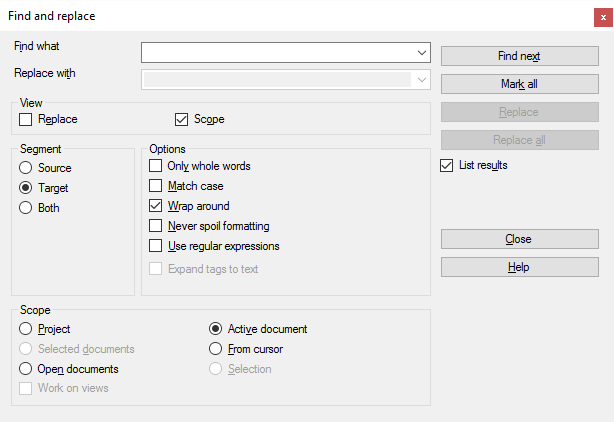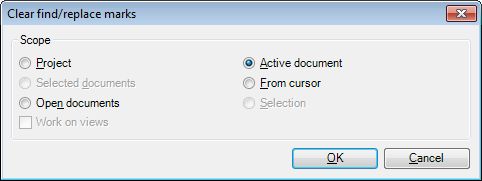|
The Find and replace dialog allows you to search for words or expressions in a translation document, alignment document or a translation memory. If the content is editable, you can replace specific occurrences with a different text. A separate dialog is available for finding or replacing text in a term base. Note: You can use regular expressions in the Find what box. This is available only when you start Find and replace while editing a document in the translation editor. You still cannot use regular expressions if you start Find and replace from other places, such as Project home / Translations.
How to beginOn the Preparation or Edit ribbon tab, choose Find or Replace. Alternatively, you can press Ctrl+F for Find, or Ctrl+H for Replace. Options•Find what: Use this drop-down list to enter the text you are looking for. If you have selected text in the document before invoking the Find and replace dialog, the selected text will automatically appear in the Find what drop-down list. The Find what text field is a drop-down list where the previous texts you entered are retained until you quit memoQ. Note: When you select text in the translation grid, and press Ctrl+F, then the Find and replace dialog is invoked with the selected text filled in the Find what field. When you do not close the Find and replace dialog and click in the translation grid, then this clears the selection and the focus is on the translation grid. The Find and replace dialog is still open, but you can work in the translation grid. Press Ctrl+F to put the focus back on the Find and replace dialog and to clear the text in the Find what field. If there is no selection when the Find and replace dialog is re-activated this way, the last searched text in the Find what field is kept. Note: When you edit a translation document, select text, and press Ctrl+F. The Find and replace dialog is invoked with the selected text filled in the Find what field. Close the Find and replace dialog. Move the caret so that there is no text selected in the translation grid. Press Ctrl+F. The Find and replace dialog is invoked with no text in the Find what field. The last searched text is selected. You can choose another last searched item from the drop-down list. Regular expressions: You can type regular expressions in the Find what box, but you need to check the Use regular expressions check box. If there is a problem with the regular expression, memoQ will display an exclamation mark next to the Find what box when you click one of the Find buttons. For more information, click the exclamation mark: it will display help on regular expressions. Finding inline tags with regular expressions: You can use regular expressions to check the insides of inline tags. To do that, check the Expand tags to text check box. memoQ will then treat inline tags as if they were part of the text. •Replace with: Use this drop-down list to enter the text with which you want the text entered into the drop-down list labeled Find what to be replaced. The Replace with text field is a drop-down list where the previous texts you entered are retained until you quit memoQ. Note: You can only replace words or expressions for the target segments, not in the source segments. Regular expressions: If you search for regular expressions, you can include the matching variables in the Replace box, too. Type $1 for the first recognized chunk; $2 for the second one; and so on. View section: •Replace: Check this check box if you want not only to look for a text but to replace it with another one. Uncheck this check box if you only want to look for a text. •Scope: Check this check box to expand the dialog to select the scope of the operation in the Scope section. When unchecked, the scope is From cursor by default. oProject: Select this radio button to search for the specified text in all segments in the project. oSelected documents: Select this radio button to search for the specified text in all segments only in the documents you selected in the Translations pane of Project home. oOpen documents: Select this radio button to search for the specified text in all segments only in the documents that are currently open. oActive document: Select this radio button to search for the specified text in all segments only in the active document. oFrom cursor: Select this radio button to search for the specified text in all segments only in the active document downwards from the cursor. This option is only available if you start the Clear translations dialog with a translation document open and active in memoQ. oSelection: Select this radio button to search for the specified text only in the selected segments of the active document. This option is only available if you start the Find and replace dialog with a translation document open and active in memoQ. oWork on views: Check this check box to search for the specified text in all segments only in the views of the project. This option is only available if you select the Project radio button. When unchecked, the scope is all the segments of the original documents of the project, excluding the segments of views. Note: The order of search or replace is the following: It always starts in the active document from cursor position, wrapping around till reaching this cursor position from the start of the document, then the next open documents to the right in the list of tabs are processed one by one from start to end. If there are no more open documents in the scope, but there are also not open documents, these remaining documents are processed one by one in the order as they are currently listed in the Translations pane of Project home. Segment section: •Source: Select this radio button if you want to search or replace text on the source side. •Target: Select this radio button if you want to search or replace text on the target side. •Both: Select this radio button if you want to search or replace text on both the source and on the target side. Options section: •Only whole words: Check this check box to find only whole words as matches (substring matches are ignored). This not only works when you only typed in one word in the Find what field like "Translation", but also when you type in e.g. "Translation Technologies", you will get search result for "Translation Technologies". •Match case: Check this check box to run a case-sensitive search. If checked, the replace expression is always inserted without adjustment. •Wrap around: Check this check box to continue searching from the beginning of the document until the starting point of the search is reached, if no more occurrences are found. •Never spoil formatting: Check this check box to pay attention on cases where a formatting tag or an inline tag is in the middle of a match or either of the bold/italic/underlined formatting types is not uniform throughout the whole match. If you click Replace, a message box requiring confirmation is displayed, while if you click Replace all, memoQ skips the affected matches and displays a warning. •Use regular expressions: Check this check box before you write up a regular expression in the Find what box. This allows much greater flexibility when searching for variable text. When you look for variable text chunks in the Find what box, you can use them in the Replace text by typing $1 for the first variable chunk, $2 for the second, and so on. Note: If you replace an expression having a tag in the middle, the tag will be put after the end of the replaced expression and a warning will be displayed. If you replace an expression having a not uniform bold/italic/underlined formatting throughout the whole match, the formatting of the whole replaced expression will follow the formatting type of the first word of the match, or if it is not uniform, then these formatting types will be removed from the replaced expression. Note: You can edit a tag to see its real name by pressing Ctrl+F9. A Regex Tagger tag's name is "mq:rxt". You can filter for "mq:rxt" to find the expression you have tagged. See also the topic on special tags. •List results: Check this check box to invoke a new Find and replace tab with a list of all segments with find/replace warnings in the scope of the operation after clicking either Mark all or Replace all. Buttons: •Find next: Click this button to look for the text entered into the Find what drop-down list or to jump to the next occurrence. •Mark all: Click this button to mark all the occurrences in the scope. •Replace: Click this button to replace the current occurrence of the text entered into the Find what drop-down list with the text entered into the Replace with drop-down list. Make sure the check box labeled Replace is checked. Note: If you disable Match case then you replace for example “this” with “THAT”. The replaced text is “That” if “This” has been found, and “that” if “this” has been found. With Match case enabled “this” is replaced with “THAT”, and “This” is not replaced. •Replace all: Click this button to replace all the occurrences. If you click Mark all in the Find and replace dialog, all matches will be marked with
Alternatively, start a new find or replace process to clear the previous marks in the scope and mark the new matches. NavigationAfter you finish searching/replacing, click Close to close the dialog. When you press Ctrl+F again when the Find and replace dialog is open, the search word or expression is updated in the Find what drop-down list in the Find and replace dialog. When you press Ctrl+H again when the Find and replace dialog is open, the word or expression to be replaced is updated in the Replace with drop-down list in the Find and replace dialog. |

